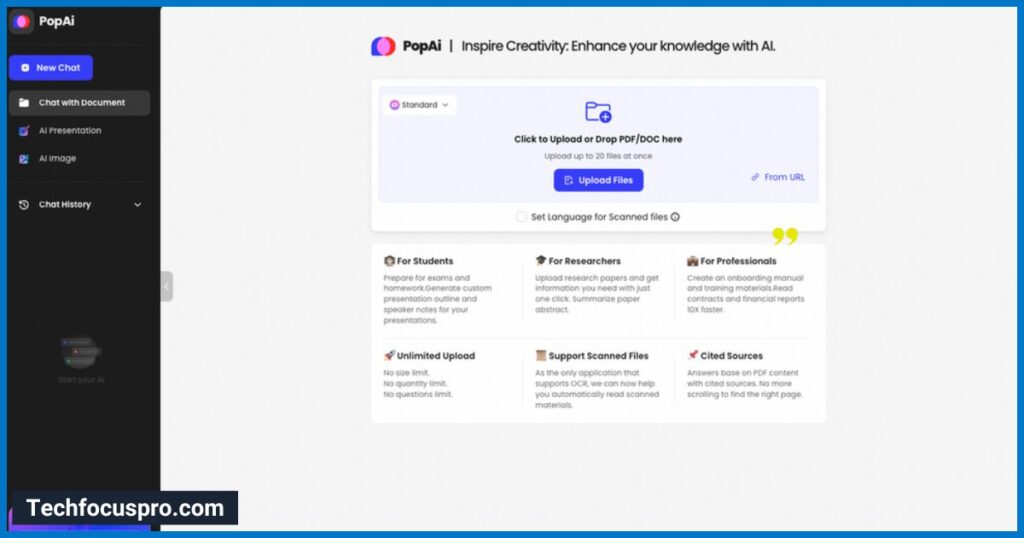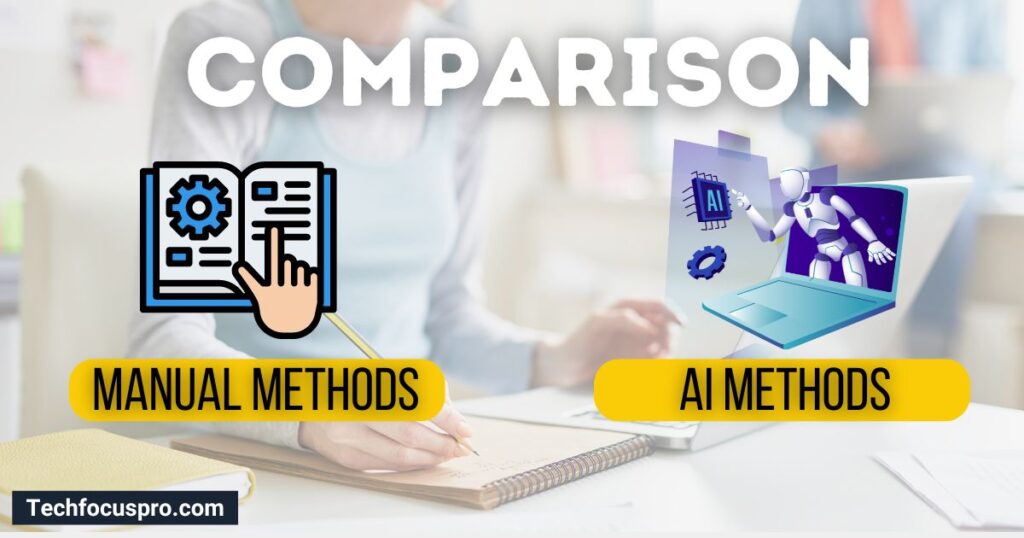How To Summarize A Book: Manual Vs. AI Methods

Summarizing a book, whether for academic purposes or just for fun, can often feel like trying to climb a mountain with no end in sight.
But what if there were easier ways to reach the summit?
Artificial intelligence tools are now able to quickly and efficiently distill lengthy texts into concise summaries. This article will guide you through both manual and AI methods for summarizing books – highlighting their pros and cons, efficiencies, and personal touches they bring or lack.
In this post we will learn in detail about “How To Summarize A Book: Manual Vs AI Methods”
Manual Methods for Summarizing a Book
Summarizing a book by hand is like doing a puzzle. You pick apart the story, piece by piece, then put it all back together in a way that’s short and sweet.
Reading and taking notes
To get the most from a book, reading and taking notes is very important. Start by finding a quiet place to focus on your book. As you read, jot down important points or quotes that stand out to you.
This method helps in better understanding the book’s main ideas and themes. It also allows for a personal touch in how you interpret what you’ve read. Creating a note or a summary of these highlights can serve as a quick reference for later review.
By taking notes while engaging with these extra resources, readers can form unique interpretations and connections that AI summarization tools cannot replicate. This personal collection of thoughts and insights deepens one’s knowledge and adds value beyond what any algorithm could offer.
Outlining the main points
Outlining the main points involves focusing on the core concepts and key messages of a book. Start by spotting the central theme.
Highlight unexpected plot twists and unconventional ideas that make a story unique or an argument more compelling. This process isn’t just about what an author says but how they say it, capturing their perspective through careful reading.
Pay close attention to details that support the central message, such as research evidence or case examples provided in the text. These elements are crucial for understanding not just what is being said, but why it matters.
Writing a concise summary
Writing a concise summary means turning hours of reading and notes, often 10-20 hours, into a clear and short essay. This process involves deeply understanding the book’s core ideas and choosing what unusual or surprising points to highlight.
Authors of these summaries work hard to make sure they include key sources and research findings. They organize their notes carefully. Their goal is to explain the book’s ideas in their own words, focusing on what stands out as most interesting or different.
Summarizing a book manually isn’t just about shrinking down the text; it’s an act of interpretation. Summarizers sift through their detailed notes from reading, extracting the essence of the author’s arguments.
They pay special attention to distilling this information into digestible parts without losing depth or meaning. The aim here is both condensing content and offering insights that capture readers’ interest by focusing on counterintuitive revelations within the book.
AI Methods for Summarizing a Book
AI methods make summarizing books much quicker. Tools like ChatGPT and PopAi can do the work in no time.
Using AI tools such as ChatGPT and PopAi
ChatGPT, a leading AI chat platform by OpenAI, has been used for creating book summaries. Feeding organized excerpts to ChatGPT can greatly enhance the quality of the summary.
For those looking into artificial intelligence tools for summarizing books, PopAi pro stands out as another great option. It offers an ai pdf reader to streamline your book summarization process.

The benefits of using AI like ChatGPT include time savings over manual methods and the ability to tweak summaries through different lenses such as personal productivity or psychology.
By supplying well-organized excerpts to these AI platforms, users save significant time and ensure their summaries capture essential insights with greater accuracy.
The benefits and limitations of using AI for summarizing books
AI summarizers, such as ChatGPT, have reshaped the way we digest research papers by making it a quicker process.
They’re lifesavers for those looking to understand complex articles swiftly since they boil down the essence into concise summaries. Plus, these tools are not limited by language barriers; they can handle multilingual content, broadening their usefulness.
Yet, this innovative approach is not without its flaws. The main snag is that AI often reaches for clichés and might miss out on delivering unexpected insights or nuanced explanations that spark a reader’s curiosity or offer deep comprehension.
While aiming to simplify text into something more digestible, there’s a chance of oversimplification where crucial details are glossed over.
Comparison of Manual and AI Methods for Summarizing a Book

How To Summarize A Book: Manual Vs. AI Methods? Lets talk about about its coparison
Comparing manual and AI ways to summarize a book opens up interesting differences. Each method shines in its own areas like speed, detail, and personal touch.
Efficiency and accuracy
AI tools like ChatGPT can whip up book summaries quickly, often in just a short time. This speed is a big plus for efficiency. But, manual summarization leads the pack in accuracy and detail.
People catch nuances and insights that AI might miss.
Manual methods take more time and effort but pay off with precise, thoughtful summaries. Meanwhile, AI can process books in different languages fast but might oversimplify or miss the mark on depth.
Time and effort
Summarizing a book by hand can take over 10 hours, not counting the time spent reading. You have to read carefully, jot down notes, and organize your thoughts before writing anything.
This method demands lots of manual work and deep thinking. On the other side, AI tools like ChatGPT offer a speedy alternative. They can churn out summaries in just a few seconds and help polish them with quick grammar checks.
Using these AI technologies means massive effort reduction for anyone looking to summarize books quickly. Imagine getting your summary ready almost instantly instead of after several days of laborious note-taking and drafting.
This switch to AI could mean more free time for other tasks or relaxation, boosting productivity significantly.
Personalization and human touch
Manual methods of summarizing a book bring out the author’s own views and unique ideas. This way, every summary is different because it reflects what the person thinks and feels about the book.
It’s like having a one-of-a-kind piece that shows your personal touch. These summaries go beyond just the main points; they weave in originality and specific insights only you can provide.
On the other side, AI tools may give us quick summaries but often miss that human touch. They tend to stick to a certain pattern, lacking new thoughts or individual style.
Even though these tools can churn out summaries using organized bits from books, they don’t offer personal enrichment or those special nuggets of wisdom you get when you explore a book yourself.
Manual ways allow for deeper understanding since they’re packed with personalized views and attention to detail that AI just can’t match yet.
The future of book summarization methods
The future of book summarization methods leans heavily on AI tools like Quillbot and ChatGPT for their ease of use and efficiency. These tools are shaping the way we digest books, offering customizable lengths to suit various needs while simplifying complex content.
This shift promises wider audience accessibility, turning dense materials into digestible snippets.
AI doesn’t just summarize; it enhances comprehension and supports decision-making by tailoring information delivery. Unlike manual methods, which struggle with customization and speed, AI brings a fresh perspective to summarization techniques.
Its ability to adapt means summaries can cater specifically to user preferences, marking a significant leap in how we approach learning from texts.
FAQs
What is the best method for summarizing a book?
The best method depends on your specific needs. If you require a deep and nuanced understanding of the book, manual summarization is preferable. However, if you need a quick overview or have multiple books to summarize, AI summarization offers efficiency and consistency.
Can AI summarization replace manual summarization completely?
While AI summarization is highly efficient, it cannot fully replace manual summarization. AI might miss subtle nuances and broader contexts that a human reader would catch. Both methods have their unique strengths and can complement each other.
How to summarize a book using AI?
To summarize a book using AI, you can leverage various AI-powered tools and applications designed for natural language processing. These tools analyze the text’s key points, themes, and concepts to generate a concise summary. Common steps include uploading the book’s text to the AI tool, selecting the desired length and detail of the summary, and allowing the AI to process and produce the summary.
How do you summarize a book?
Summarizing a book manually involves several steps:
- Reading Thoroughly: Read the book carefully, taking notes on key themes, characters, and plot points.
- Identifying Main Ideas: Pinpoint the essential arguments and ideas presented by the author.
- Condensing Information: Rewrite the text in a more succinct form, focusing on the core elements.
- Reviewing and Refining: Re-read the summary to ensure it accurately captures the book’s key points and artistry.
Can I use AI to summarize a PDF?
Yes, many AI summarization tools can handle PDFs. By uploading the PDF file to the AI tool, the software can extract and analyze the text within, then generate a summary based on the content. This is especially useful for academic papers, research reports, and lengthy documents.
Is there an AI for summarizing?
Yes, there are numerous AI tools specifically designed for summarizing text. Popular examples include OpenAI’s GPT-3, Microsoft Azure Text Analytics, and various other natural language processing tools embedded in applications like Google Cloud’s Natural Language API. These tools utilize advanced algorithms to effectively summarize large volumes of text with speed and consistency.
Conclusion
Summarizing a book can be easy or hard, but you have choices. You can write notes and outlines by hand or use AI tools like ChatGPT. These AI helpers work fast and handle many languages.
Yet, writing summaries yourself adds a personal touch that machines can’t match. Think about which method saves you time and suits your needs best. So, why not give both ways a try and see what works for you?






